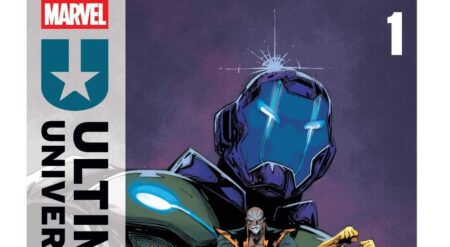
Punisher #4 is published by Marvel Comics, written by Jason Aaron, art by Jesús Saiz and Paul Azaceta, colours by Dave Stewart, and letters by Cory Petit. In the last issue, Punisher’s soldiers had a brutal encounter with Ares. In this issue, they prepare for the next battle as Castle’s relationship with the Hand meets new challenges.
This series has routinely had a slower pace—not all-out war as other Punisher comics can sometimes be. In the aftermath of the massacre last issue, there is a feeling of something bigger coming throughout Punisher #4. The first scene sets up the unease for the union between Frank and his new army. But there is also more evidence of his ascendency as the Fist, the true leader of the Hand. There is a surprise guest appearance in this issue, but the motivation behind it is not difficult to guess. Aaron practically spells it out. The confrontations are interesting but can also come across as disjointed as it is split between two places. The true unexpected part of the story comes at the end.
The characters are strange but engaging. Castle has never been emotive, and this is at its most evident when he is with his reincarnated wife, Maria. These moments are uncomfortable and awkward, as she never really moves away from one particular area. These parts of this issue are intentionally heartbreaking. Frank does not display much emotion at all in these instances, often ushering Maria away at some point, and it can get more repetitive every time it happens.
Ares is a menacing villain, radiating power and arrogance. The most interesting character in the whole series is the Priestess, though. She is in awe of the perfect killer Castle is and has been trying to mold him into a true follower of the Hand. But their philosophies only meet at the killing. The Priestess is devoted to the Beast and is willing to execute her own ninjas if they do something that displeases her. Punisher only kills someone if they have committed a crime. And that can lead to friction.
The art does have some problems. Some of this isn’t entirely the fault of the artists, but rather the location the story is set in. The citadel has already been seen before, and the Punisher surrounded in the grand halls by ninjas is starting to grow old. The two guest stars look fantastic, and there are periods of their battle which shows flashes of brilliance. But Saiz’s style can negate any sensation of motion or speed, which is really important in a comic filled with ninjas, There are a few glimmers of extreme violence, but often it is the aftermath of a fight that is shown. The character with the best design in my opinion is Ares, as his sheer size and his insidious grins through his helmet make him incredibly imposing. It should also be said that Azaceta also has a few pages in Punisher #4, depicting Frank’s childhood. This is a style that has more personality and the scruffiness fits the brutal landscape of the story.
The colours are also starting to go old. The ninjas are red and almost everything else is black, and this hasn’t changed much. It leads to many of the panels simply looking the same for long periods of time. The lettering is very clean and easy to read though.
Punisher #4 is at a strange precipice. The story is getting very interesting, as what Punisher and the Hand want to achieve are starting to differ in their destinations. The final part of the comic in particular completely alters the direction the story was heading in, making me nervous for the next issue. But the art is getting monotonous and lacks variety in events. The entire comic needs to maintain momentum or else it risks grinding to a stop.
Punisher #4 is available where comics are sold.
Punisher #4
TL;DR
Punisher #4 is at a strange precipice. The story is getting very interesting, as what Punisher and the Hand want to achieve are starting to differ in their destinations. The final part of the comic in particular completely alters the direction the story was heading in, making me nervous for the next issue. But the art is getting monotonous and lacks variety in events. The entire comic needs to maintain momentum or else it risks grinding to a stop.







